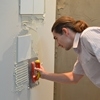Glaze is a shiny or enamel glassy layer in the form of a thin film (0.1 - 0.3 mm). The chemical composition of the glaze and the ceramic shard is different. Their thermal expansion also varies in size. For strong adhesion of the glaze layer to the shard, one must strive to ensure that the thermal expansion of the glaze and the shard is equal. The fragility of the adhesion of the glaze to the shard is expressed in the formation of a network of cracks in the glaze layer (cek) or the detachment of the glaze from the shard after firing and cooling. Thermal expansion of glazes and ceramic masses is characterized by the coefficient of thermal expansion (CTE). The CTE value of the glaze depends on its chemical composition. If the discrepancy between the CTE of the glaze and the shard is small, the network of cracks in the glaze is large; the greater the discrepancy, the finer the mesh. This property is used in the decorative technique of crackle. To avoid the formation of cracks, the glaze is applied in a thin layer, and finely ground quartz sand is also added to the glaze. Often the ceque does not form immediately after firing, but over time.
Tsek is a type of glaze defect. This occurs due to the difference in the expansion coefficients of the shard and the glaze itself. The center has the appearance of web-like cracks.
Glazes can be classified according to: manufacturing method, chemical composition, melting point, transparency.
Preparation method
Raw glazes . Raw materials (quartz, feldspar, kaolin, metal oxides) are ground, and the resulting mixture is loaded into a ball mill with water. Grinding of the glaze is carried out within 48-72 hours, depending on the strength of the raw materials. Raw glazes should not contain components that are soluble in water, otherwise these components, when the glaze suspension is applied to the product, together with water, will go into the porous shard, changing the composition of the glaze.
Fritted glazes . The main component for making glaze is silicon, its melting point is 1730 o C, which is not suitable for firing ceramic products. To lower the firing temperature of the glaze coating, the glaze is fritted. All glaze ingredients in dry form are mixed and fired at a temperature of 1000 - 1300 o C. The resulting molten mass is sharply cooled with water. The glaze breaks down into small granules, which are subsequently ground in a ball mill. The fritting process of glaze requires a huge amount of energy, which significantly increases the cost of its production. Fritted glazes are more fusible than raw glazes of the same composition, and their surface quality after firing is higher.
Frit is a special type of glass that, during the firing of the tile, melts and adheres tightly to the shard. Glaze, consisting of frits only, is used only to achieve a shiny surface on some types of wall tiles.
Chemical composition
According to the chemical composition, glazes include boron, alkaline (sodium, potassium), lead, tin, and zinc. Historically, lead and tin glazes were the first to be used.
Lead glazes . Until recently, one of the most common types of glaze. Currently, this species has limited use due to environmental protection requirements, since it is poisonous. Lead glazes have a rich color spectrum.
Tin glazes . Historically they were widely used for creating blind glazes. Now they have limited use due to their high cost.
Glazes containing boron are fired at a temperature of 750 o C. Boron gives elasticity to the glaze, lowers the CTE, and increases brightness. When combined with copper oxide, it gives the glaze turquoise shades.
Alkaline glazes affect metal oxides, resulting in clear and pure tones, and also reduce CTE.
Zinc glazes . At low levels, zinc imparts brightness. With increased content, it imparts a matte finish. If you add an even larger amount, the crystallization process begins, which causes a certain decorative effect.
Melting temperature
Based on melting temperature, the following classes of glazes are distinguished:
- Refractory with a high content of quartz - 1200 ... 1410 ° C;
- Medium melting – 1000…1150 °C;
- Low-melting - 900 ... 1050 °C.
Glazes with other melting temperature ranges are practically not used in tile production technology.
Transparency
Transparent glazes are used to cover tiles of white-burning clay (white and light tones); they preserve and enhance the color of the ceramic shard. Transparent glazes are colorless and colored. I use opaque glazes (or dull ones) to mask unwanted colors, for example, red-burning shards. Opaque glazes are also called enamels. To obtain colored glazes, metal oxides or industrially produced dyes are introduced. Oxides are natural raw materials. It is very difficult to determine the color of the material in its raw state: it fluctuates in gray-black tones. After firing, the oxides change color depending on the quality of the glaze that is added to them or the temperature to which they are subjected during firing.
The article was based on the following materials:
“Ceramic tiles: a modern encyclopedia” comp. Sergeeva E.E. Estima company .
There is 1 Comment
Metal oxides
As mentioned in the article, the addition of metal oxides allows you to obtain colored glazes. It is known from practice how such components affect the resulting color. So:
- iron oxide - brown;
- cobalt oxide - blue;
- chromium oxide - green;
- copper oxide - light green, black, red;
- manganese oxide - metallic shade;
- uranium oxide - yellow and gray.
- Login to leave comments

